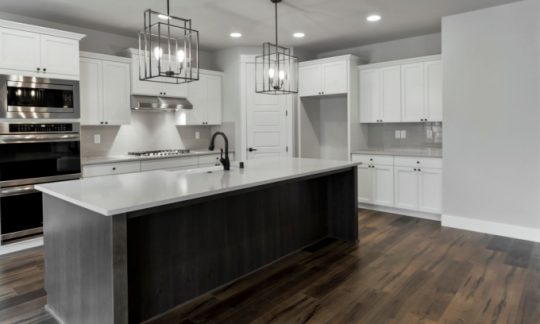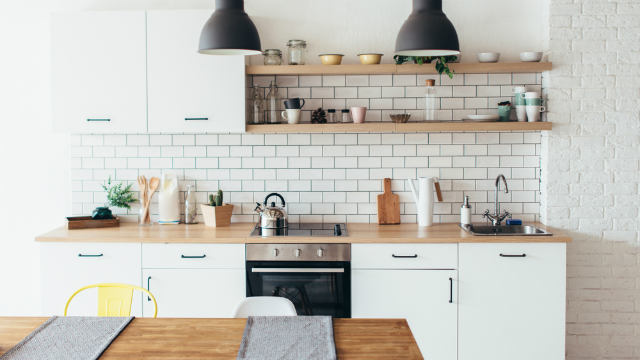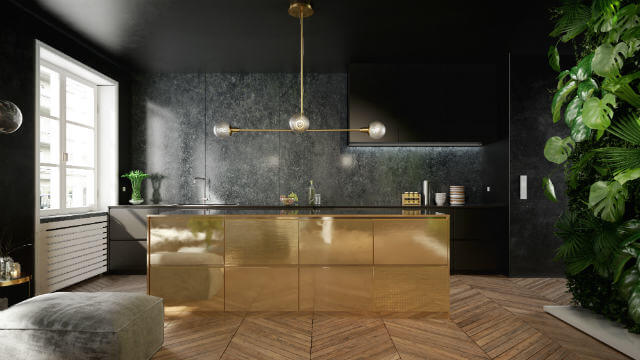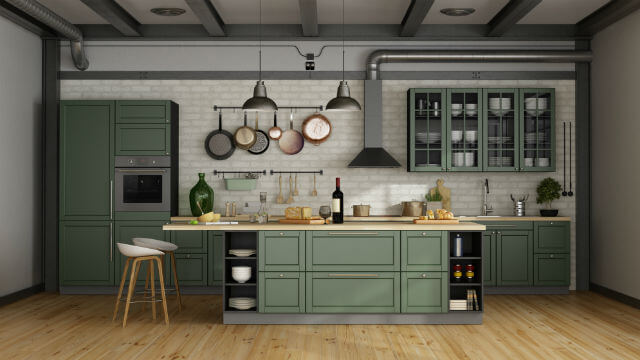Kitchen renovation costs: How much for a new look?

Maybe you’re thinking of updating one element of your kitchen to keep it fresh – installing a shiny new splashback, say, or some stone benchtops. It might even be that you’re ready to completely gut the room and undergo a makeover. So what does a kitchen renovation cost? Whatever the size of the job you’re pondering, here are some important things to know.
Kitchens are the heart of the home – a place where we gather to cook, talk, eat, work and entertain our loved ones. If you’re itching to renovate and turn your kitchen into a space that will make you feel as warm inside as a freshly-baked tray of muffins from your new oven, you’ll no doubt be wondering how much your dream will cost and what upgrades your budget will allow.
So how much can a kitchen renovation cost these days? In recent times, the cost of renovating a kitchen has grown, thanks to both the pressures of inflation, and ongoing supply chain issues brought on by the pandemic. In the present landscape, it could therefore be challenging for home owners to work out how much a kitchen renovation might cost without obtaining a few quotes from suppliers.
Nonetheless, we’ve taken a look at some current estimates for the cost of renovating a kitchen – here’s what the experts have to say.
What’s the average cost to renovate a kitchen?
According to various major Australian trade websites, you might currently expect the following cost for a kitchen renovation:
- Airtasker.com states that the average cost is between $10,000 and $50,000
- hipages.com.au states that the national average on their site was between $22,000 and $40,000
- service.com.au states that the average cost was between $17,000 and $40,000, with costs as low as $15,000 and as high as $45,000 or more

What are the options to finance a kitchen renovation?
How you finance the work on your kitchen may depend on how big the job is, which will impact how much it costs. There are several options available for would-be home renovators or DIY enthusiasts to consider, including:
- Home loan: If this job is big enough, or you are doing a range of jobs at the same time, one choice you may consider is refinancing or restructuring your home loan, or adding a ‘line of credit’. For example, depending on your lender you may be able to add a redraw facility to your existing loan (although it’s wise to keep in mind that some fees could apply to any loan changes and there could be redraw limits). Or, you could add an offset account, which could help reduce the interest paid on your loan, while still allowing access to your money (although it’s wise to keep in mind there could be some fees involved here, too, and higher interest rates could apply to these types of loans). You can compare home loans with Canstar.
- Personal loan: Depending on your personal circumstances and the cost of the job, you may consider using a personal loan to fund the work. This could be a secured loan, or an unsecured loan. It’s worth keeping in mind, though, that interest rates are generally higher for personal loans than for home loans, and it’s a good idea to read the lender’s terms and conditions first. You can compare personal loans with Canstar.
- Credit card: It may also be possible, depending on the cost and your ability to repay the debt quickly, to pay for the job on a credit card. There could be some fringe benefits for doing so, such as extra insurance cover in some cases. Keep in mind that credit card interest rates are typically much higher than home or personal loans, and interest can quickly accumulate on large balances, so it is a good idea to weigh up your options and consider them carefully. If you don’t think you’ll be able to pay off the card’s balance in full each month, it may be worth re-considering whether a credit card is the right option for you. You can compare credit cards with Canstar.
If you are considering borrowing money with a personal loan or on your credit card to finance a kitchen renovation, you may like to ask for a copy of the Product Disclosure Statement (PDS) and Target Market Determination (TMD) from the lender. Similarly, if you decide to refinance or take out a line of credit on your home loan, it’s a good idea to read through any relevant documents before making a decision.
→ Want to know more? Financing a renovation – loan, refinance, or out of pocket?
Compare Home Loans (Refinance with variable rate only) with Canstar
If you’re currently considering a home loan, the comparison table below displays some of the variable rate home loans on our database with links to lenders’ websites that are available for homeowners looking to refinance. This table is sorted by Star Rating (highest to lowest), followed by comparison rate (lowest to highest). Products shown are principal and interest home loans available for a loan amount of $500,000 in NSW with an LVR of 80% of the property value. Consider the Target Market Determination (TMD) before making a purchase decision. Contact the product issuer directly for a copy of the TMD. Use Canstar’s home loans comparison selector to view a wider range of home loan products. Canstar may earn a fee for referrals.
The comparison rate for all home loans and loans secured against real property are based on secured credit of $150,000 and a term of 25 years.
^WARNING: This comparison rate is true only for the examples given and may not include all fees and charges. Different terms, fees or other loan amounts might result in a different comparison rate.
 Owner occupied
Owner occupied
 20% min deposit
20% min deposit
 Redraw facility
Redraw facility

Up to $3,000 when you refinance with a Greater Bank home loan. Minimum loan amounts and LVR restrictions apply. Offer available until further notice. See provider website for full details. Exclusions, terms and conditions apply.
 Owner occupied
Owner occupied
 20% min deposit
20% min deposit
 Redraw facility
Redraw facility
 Owner occupied
Owner occupied
 20% min deposit
20% min deposit
 Redraw facility
Redraw facility
 Owner occupied
Owner occupied
 5% min deposit
5% min deposit
 Redraw facility
Redraw facility
 Owner occupied
Owner occupied
 10% min deposit
10% min deposit
 Redraw facility
Redraw facility
Canstar is an information provider and in giving you product information Canstar is not making any suggestion or recommendation about a particular product. If you decide to apply for a home loan, you will deal directly with a financial institution, not with Canstar. Rates and product information should be confirmed with the relevant financial institution. Home Loans in the table include only products that are available for somebody borrowing 80% of the total loan amount. For product information, read our detailed disclosure, important notes and additional information. *Read the comparison rate warning. The results do not include all providers and may not compare all the features available to you.
Home Loan products displayed above that are not “Sponsored or Promoted” are sorted as referenced in the introductory text followed by Star Rating, then lowest Comparison Rate, then alphabetically by company. Canstar may receive a fee for referral of leads from these products.
When you click on the button marked “Enquire” (or similar) Canstar will direct your enquiry to a third party mortgage broker. If you decide to find out more or apply for a home loan, you can provide your details to the broker. You will liaise directly with the broker and not with Canstar. When you click on a button marked “More details” (or similar), Canstar will direct your enquiry to the product provider. Canstar may earn a fee for referral of leads from the comparison table above. See How We Get Paid for further information.
When should I renovate my kitchen?
While few people renovate kitchens less than five years old, if you’re feeling guilty about wanting to renovate your decade-old kitchen, it might help to know you’re not alone.
A Housing Industry Association (HIA) Kitchens and Bathrooms survey found the overwhelming majority of kitchen renovations in Australia – 78% – were performed in homes that were between 11 and 20 years old.

What affects the cost of a kitchen renovation?
Things that could impact the cost of a kitchen renovation could include:
- As discussed, the wider economic environment can impact the cost of a kitchen renovation.
- The older your home is, the more extensive your kitchen renovations are likely to be in order to upgrade it. For example, if your wiring is not up to current standards, that may have to be replaced.
- The physical size of your kitchen will also have an impact on the cost of upgrading it. HIA figures show the majority of kitchen renovation jobs involve enlarging the footprint or changing the physical size of a kitchen, so you might want to have a little more saved up to allow for an expansion.
- Prices will also depend on the quality of the materials, fixtures and fittings you choose, and whether you hire tradespeople to install your kitchen or do it yourself.
- It’s important to remember that quotes are estimates of what the work is expected to cost. These estimates could change as the project progresses, especially if there are delays caused by factors like supply issues or changes to your original plans.
- New work could also uncover existing problems, such as water-damaged house frames or mould infestations, which can also mean delays, the need for more materials and, subsequently, higher costs.
When planning your budget, it can be a good idea to consider leaving room for cost overruns.
What parts of the kitchen cost what?
The materials you choose for your kitchen will have a big impact on the cost of your renovation, whether it’s for your benches, splashbacks and cabinetry or your handles, tapware and sinks. Price typically differs according to a product’s quality, style, popularity or a combination of these factors.
Generally, the higher the quality of a product, the more it will cost, as those kinds of products are often marketed as being designed to perform better over time, or to require less maintenance. For example, more expensive tap ware could have more durable washers or be made of metals less prone to corrosion. Another example is the type of surface chosen for benchtops – hard-wearing, solid stone usually costs more than cheaper, thinner laminated board.
The styling of a product can also change the cost of a product. For example, tiles can differ in price depending on how they are decorated. Generally, hand-painted tiles or artisan-glazed ceramics are considerably more expensive than mass-manufactured options in standard colours. Natural stone also usually costs more than manufactured tiles, even though they may look similar.
Architecture Australia states that using certain finishes could be more expensive than others. Below is a list of surfaces, listed from generally less expensive to the more expensive:
Average bench costs: cheapest to most expensive
- Laminate bench top
- Stone bench top
- Hardwood timber or stainless steel bench top
- Natural stone or marble bench top
Average splashback costs: cheapest to most expensive
- Tile splashback (highly variable depending on type of tile)
- Acrylic splashback
- Glass splashback
Average cabinet costs: cheapest to most expensive
- Melamine (made from compressed wood covered with paper and resin)
- Polyurethane (a more durable board covered in paint that has been mixed with a hardener)
- Two-pac (a special, two-part paint finish that is generally harder and more durable than other coatings)
Average appliance costs
The HIA and Archicentre average price estimates do not include appliances. These workhorses of the kitchen – stove, oven, fridge, microwave, dishwasher and other electrical items – can also be a considerable added expense when it comes to updating a kitchen.
Fortunately, there is also a wide range of choices and a competitive market for prices. For example, while there are some ovens available to buy for under $500, larger models with more functionality made by quality brands can run into the thousands of dollars.
When choosing an appliance, you may want to consider the size of the space available to fit it, how it will be powered or fueled (in the case of gas ovens and cooktops), and what functions you require it to perform. For example, some gas cooktops have a special fitting for woks, while others have built-in teppanyaki or grill plates. If you have solar panels installed, you may also want to consider options like running an induction cooktop with an off-the-grid solar system to improve the energy efficiency of your kitchen.
The installation of some appliances requires an electrician, plumber or other suitably qualified and licensed professional.
→ Renovating a home could change what insurance cover you may need. Compare home and contents insurance providers.

How long does it take to renovate a kitchen?
How long it would take to renovate a kitchen depends on many factors, including the extent of the renovations, who does them, and the materials chosen. Tradie and material shortages could also impact this timeframe, so it could be a good idea to factor in extra time to any renovation plans. But a review of various companies’ published estimates indicates that it could vary on average between four and six weeks, for the average renovation.
It may be possible to stay in the home while the renovations are taking place, unless you’re making some serious structural changes to the room. It’s a good idea to remember that you probably won’t have a kitchen to use during this time. While the toaster and kettle might do just fine on the dining table for a week, you may have to plan alternative ways of catering for your household. You might find yourself embracing the convenience of take-away – which could become costly – or have some ready-to-heat meals prepared to pop in the microwave. And then there’s always the barbecue. However you decide to solve the food preparation issue, it could be something to consider when preparing the budget for your project. If you plan to use restaurant deliveries while you renovate your kitchen, you can compare ratings for food delivery services such as deliveroo, Doordash, Uber Eats and Menulog with Canstar Blue.
→ Want more reno content? From bathrooms to butler’s pantries, Canstar’s Renovations Hub could have what you need.
Cover image source: Pixel-Shot/Shutterstock.com
This article was reviewed by our Editor-in-Chief Nina Tovey before it was updated, as part of our fact-checking process.

Alasdair Duncan is Canstar's Content Editor, specialising in home loans, property and lifestyle topics. He has written more than 500 articles for Canstar and his work is widely referenced by other publishers and media outlets, including Yahoo Finance, The New Daily, The Motley Fool and Sky News. He has featured as a guest author for property website homely.com.au.
In his more than 15 years working in the media, Alasdair has written for a broad range of publications. Before joining Canstar, he was a News Editor at Pedestrian.TV, part of Australia’s leading youth media group. His work has also appeared on ABC News, Junkee, Rolling Stone, Kotaku, the Sydney Star Observer and The Brag. He has a Bachelor of Laws (Honours) and a Bachelor of Arts with a major in Journalism from the University of Queensland.
When he is not writing about finance for Canstar, Alasdair can probably be found at the beach with his two dogs or listening to podcasts about pop music. You can follow Alasdair on LinkedIn.
The comparison rate for all home loans and loans secured against real property are based on secured credit of $150,000 and a term of 25 years.
^WARNING: This comparison rate is true only for the examples given and may not include all fees and charges. Different terms, fees or other loan amounts might result in a different comparison rate.
 Owner occupied
Owner occupied
 40% min deposit
40% min deposit
 Redraw facility
Redraw facility
Try our Home Loans comparison tool to instantly compare Canstar expert rated options.
The comparison rate for all home loans and loans secured against real property are based on secured credit of $150,000 and a term of 25 years.
^WARNING: This comparison rate is true only for the examples given and may not include all fees and charges. Different terms, fees or other loan amounts might result in a different comparison rate.







